 |

 |
 |
Seated Male Figures after Ancient Roman Sculptures, Jacques-Louis David, 1770s
|
 |
 |
|
Drawn to Rome explores sketches and prints by young French painters and architects who studied in Rome.
A stay in the Eternal City was considered essential to an artist's training in the 18th century. Young artists wandered Rome, sketching palaces and churches, Roman ruins, ancient sculptures, and Italian paintings. Many artists later published prints of their sketches, heightening the allure of Rome for audiences back home.
Most of the artists in this exhibition were winners of the coveted Prix de Rome, a scholarship sponsored by the French government. Winners of the prize studied at the French school in Rome for three or more years.
|
 |
|
Jacques-Louis David was the most influential European artist of the late 18th century. An obsessive student of ancient and Renaissance art, David made well over one thousand sketches during his student years in Rome in the 1770s. Back in Paris, he dismantled his sketchbooks and reorganized the sketches into albums according to type. David relied on his Roman sketches as a visual resource throughout his career.
|
 |
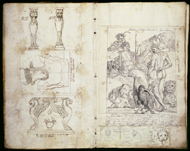
 |
 |
Sketches after Sculpture, Decorative Arts, and a Fresco from Herculaneum, Élie-Honoré Montagny, 1800s
Recent Acquisition
|
 |
 |
The album owned by the Research Library, of which a page is shown above, contains copies of bas-reliefs and sculptures from prominent Italian collections.
Many artists saw the ancient Roman paintings unearthed in Pompeii and Herculaneum. Few sketched them, however, because the local government prohibited copying.
A sketchbook by Élie-Honoré Montagny, a student of David, contains a rare set of drawings of the frescoes (or paintings) of Herculaneum.
The sketchbook also contains numerous drawings of ancient sculpture and decorative arts, such as the one shown here. Many of these drawings were later reproduced in a massive illustrated catalog titled Iconographie ancienne.
|
 |
 |
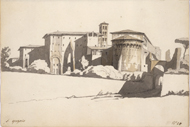
 |
 |
SS. Giovanni e Paolo near San Gregorio, Rome, Louis Gauffier, 1784–1789
|
 |
Louis Gauffier started as a student of a rococo painter, but quickly fell under Jacques-Louis David's Neoclassical influence. This drawing of a medieval church reflects David's preference for architectural forms reduced to basic geometric patterns.
Because of the unrest of the French Revolution, Gauffier could not return to France permanently. He spent most of his short life in Italy, earning his living as a portrait painter.
|
 |
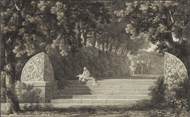
 |
 |
Entrance to the Garden of the Villa Panfili, Rome, Charles Percier and Pierre-François-Léonard Fontaine, 1800s
|
 |
 |
Many French artists who traveled to Italy published books about ancient Greece and Rome. The images in these books changed the way artists, critics, collectors, and others understood ancient art.
Architects Charles Percier and Pierre-François-Léonard Fontaine published drawings of ancient monuments and original designs based on classical models. This image shows the entrance to the Villa Panfili, a 17th-century country estate.
|
 |
 |
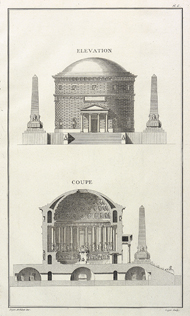
 |
 |
Cross-Section and Elevation of the Tomb of Metella, Rome, Marie-Joseph Peyre, 1760s
|
 |
Marie-Joseph Peyre published his Oeuvres d'architecture in 1765, ten years after returning to Paris from Rome. In this book he mixed studies of antiquity with his own original designs.
Peyre included measured reconstructions of ancient buildings, such as the one shown here, and his designs inspired by them. The book boosted the popularity of classical architecture in France.
|
 |
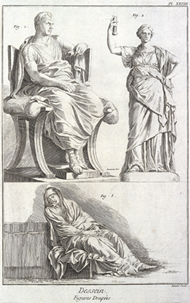
 |
 |
Draped Figures, Charles-Nicolas Cochin II, about 1760s
|
 |
 |
Many 18th-century drawing manuals illustrated paintings, sculptures, and buildings from Rome. Art students in France copied these illustrations, developing a taste for Rome long before they ever set foot in the city.
The top two images on this page, which comes from a drawing manual by Charles-Nicolas Cochin, reproduce sculpture from Rome. The page was designed to look like a leaf from a sketchbook.
The Louvre opened as a public museum in the 1790s. Artists were able to copy art that had been hidden in royal collections, as well as masterpieces looted from other countries by Napoleon's armies.
|
 |
 |
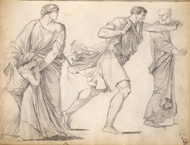
 |
 |
Figures after Laurent de La Hyre's Life of St. Stephen, unknown French artist, late 1700s or early 1800s
Recent Acquisition
|
 |
The war booty included many of the antiquities that had been drawn by artists in Rome.
In 1797 the revolutionary agency in charge of the arts confiscated and exhibited a large body of artwork, including drawings of the Life of St. Stephen by 17th-century French artist Laurent de La Hyre. An unknown artist copied figures from La Hyre's drawings onto this page as part of his own Neoclassical sketchbook.
The exhibition is located at the Getty Center, Research Institute Exhibition Gallery.
|
 |






